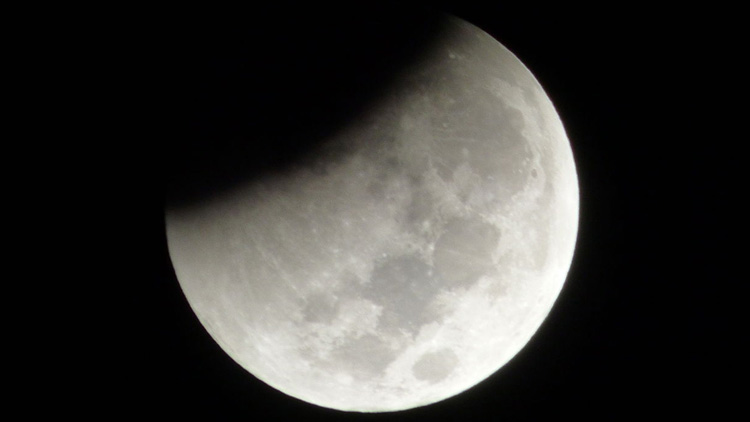September 27 & 28 mark a rare celestial event.
First, it will be a full moon. Second, the moon will be in perigee—its closest proximity to Earth along its elliptical orbit. Third, the moon will be undergoing a total lunar eclipse, whereby it passes directly behind the Earth, cloaked in its shadow.
The latter positioning will give the moon a blood-red tint, thus, the return of the ominous, so-called “Blood Moon.”
NASA states the full perigee moon appears up to 14 percent larger and up to 30 percent brighter than when it is at its farthest Earth approach, called its apogee. Thus, this upcoming September 27 & 28 lunar phenomenon, dubbed a “SuperMoon” in the 1970s by astrologer Richard Nolle, will be bigger, brighter (before it dims and goes dark)—and blood red.

This extraordinary cosmic convergence has once again sent intergalactic chills down the spines of countless Web surfers, Doom’s Day prophets and religious folk across the globe who fear its blood-curling horrifying hue and gigantic size are omens of great calamity and upheaval—even a bone-shivering signal of the Apocalypse.
Such foreboding anguish and dread is not extraterrestrial (See what we did there? #SuperMoon #BloodMoon #powww) to such interstellar happenings. The March 19, 2011 SuperMoon—also a full moon at lunar perigee—incited fears across the globe of natural disasters and other worldwide catastrophes. (It came on the heels of the 9.0 undersea megathrust earthquake—known as the 2011 Tohoku Earthquake and Tsunami—which pulverized Japan and spawned devastating tsunamis that claimed more than 15,000 lives and caused nuclear meltdowns at the Fukushima Daiichi Nuclear Power Plant.)
Click Here For More Photos Of A SuperMoon
Nolle, who publishes astrological predictions on his website astropro.com, has much to say about this upcoming lunar leviathan. His “September 2015 Forecast” warns not just of the havoc caused by the impending lunar eclipse and SuperMoon, but also of untold solar and geophysical events resulting from a “Mercury Max”—“a phase in the Earth-Mercury-Sun relationship,” he explains, “when Mercury swings around from behind the Sun to catch up and pass the slower orbiting Earth. As it does this, Mercury draws closer and closer to our home planet, until it reaches its perigee… At this time, Earth, Mercury and the Sun are aligned with Mercury in the middle, passing between us and the Sun.”
All these happenings equate into one hell of a month, according to Nolle. Among some of the mayhem, he predicts heightened risks of solar and geophysical storms, extreme tidal surges, and volcanic and seismic events.
“September shapes up to be the biggest geophysical news story of the year: two eclipses (one of them a SuperMoon) plus a Mercury Max make for a lot of turbulence in Earth’s crust, seas, atmosphere and magnetosphere,” he foretells. “It all adds up to a huge potential for powerful storms and seismic activity; along with an increase in solar storms that heighten risks for breakdowns in electrical and electronic equipment—including the bioelectric field that is human consciousness. Sometimes the world can feel haywire and out of control. This month looks like one of those times.
“Bringing up the rear this month is the September 28 total lunar eclipse full moon at 4°41’,” continues Nolle. “This one occurs just a couple days before the Sun’s inferior conjunction with Mercury, the anchor point of the current Mercury Max cycle. This points to a heightened risk of a solar storm outburst sometime between September 27 and October 1, which is more or less contiguous to the September 25-October 4 SuperMoon geophysical storm window. This very strongly suggests an unusual outbreak of strong storms and seismic activity (including volcanic eruptions) during this particular SuperMoon stress window.
“Being astronomical in scale, a SuperMoon is at least potentially planet-wide in scope,” he continues. “Aside from the obvious targets—the coasts for extreme tidal surges, and known volcanic and seismic risk zones—the atmosphere gets a good SuperMoon stirring that can manifest as powerful storms packing high winds and heavy precipitation just about anywhere.
“With this in mind, even though I don’t live anywhere near (nor plan to visit) any tidal basins, volcanoes or seismic hot spots during the September 25-October 4 SuperMoon shock window, I still plan to make sure the bottled water, canned and dried foods and other emergency supplies are ready to hand; just in case,” adds Nolle. “That said, it doesn’t take more than a cursory glance at an astro-locality map for the September 28 SuperMoon to recognize that this one is a complex snare of risk lines. This is due to the fact that so many planets join the Sun and Moon in making important configurations in the sky at this time.”
Just as in 2011, NASA has taken to cyberspace to provide scientific data on this latest lunar flyby and perhaps quell some of the anxiety surrounding any alleged adverse effects the moon’s close proximity would render on Earth.
On Aug. 31, NASA published an animated feature video about the rare rendezvous, which doesn’t make it seem all that frightening at all.
Watch video here:
On Sept. 1, Jane Houston Jones from NASA’s Jet Propulsion Laboratory in Pasadena, Calif. published a post and podcast on nasa.gov about the Blood SuperMoon, too. [Listen To NASA’s Jane Houston Jones’ Blood Moon SuperMoon Podcast HERE] Her explanation counters Nolle’s assertion on his website that he coined “SuperMoon” decades ago, and also tones down the extraordinariness of the event.
“On the evening of September 27th, observers in North and South America will see a long total lunar eclipse—lasting 72 minutes. This eclipse is also visible in Europe and Africa,” she explains. “It’s the night of the harvest moon—the full moon closest to the September equinox.
“Sometimes a full moon is called a “supermoon”—a term coined just a few years ago,” she continues. “A supermoon is a new or full moon which occurs when the moon is at or near its closest approach to Earth in a given orbit.
“There are four to six supermoons every year on average, so they’re not unusual,” adds Houston Jones. “You won’t really be able to see the difference between this full moon and any other one with your eyes. It’ll only be about 7 percent larger. The moon is 221,000 miles from Earth this month, as opposed to the average distance of 239,000 miles.”
She and NASA’s assertions have done little to squash the fears of so many who fear the Blood-Red SuperMoon as an ominous harbinger of horror and dread, however.
A Sept. 1 article in Christian Today titled “‘Blood Moon’ This September Could Be Biblical Sign Of Apocalypse, Pastors Say,” for example, begins by quoting the Bible:
“In Acts 2:20, Peter the Apostle, warned of these signs of the Apocalypse: ‘The sun will be turned to darkness and the moon to blood before the coming of the great and glorious day of the Lord.’
“Similarly, Revelation 6:12 described the same Apocalyptic signs: ‘I watched as he opened the sixth seal. There was a great earthquake. The sun turned black like sackcloth made of goat hair, the whole moon turned blood red,’” it continues.
The article goes on to tell how two pastors—Mark Blitz and John Hagee—believe the Blood-Red Supermoon could be telltale signs of the potential oncoming Apocalypse, citing its timing as the last of the four so-called “Blood Moons” within the last 18 months, its close proximity to Pope Francis’ visit to the United States, and the increase in global seismic activity in recent years.
One thing’s for sure, dear readers. The Sept. 27 & 28 “Blood Moon” “Supermoon” has captured the imaginations—and fears—of countless worldwide and will be a cosmic-lunar spectacular of epic proportions that viewers will remember long after its crimson hues fade back into the bright, white, familiar amber glow we Earthlings all know and love.



























